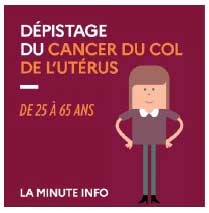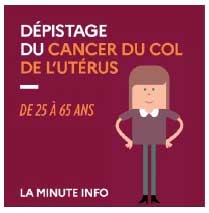Each year, nearly 3,000 women develop cervical cancer and 1,100 women die from it, while for the World Health Organization, the Cervical cancer would be totally eliminable thanks to two effective and complementary interventions: screening and vaccination, which prevents human papillomavirus (HPV) infections included in the vaccine. On the occasion of the European Cervical Cancer Prevention WeekPublic Health France publishes an update of national and subnational estimates of the coverage of the organized cervical cancer screening and recalls vaccination coverage. Vaccination coverage against HPV among adolescents has been increasing for several years but remains insufficient and participation in screening must increase. The National Cancer Institute recalls the importance of informing women about the prevention of cancer of the cervix and the complementarity of vaccination from the age of 11 and regular screening from 25 to 65 years old.
59% of women aged 25-65 were screened for the period 2018-2020
Cervical cancer screening aims to detect precancerous lesions and treat them before they develop into cancer. It also makes it possible to detect and treat cancers at an early stage and thus improve the chances of recovery. Since 2018, it has been part of an organized national program. Its objective is to reach women who do not or do not regularly undergo screening.
Each year, in France, 3,000 cases of invasive cancer of the cervix are diagnosed and 1,100 patients die of it.
Each year, in France, 3,000 cases of invasive cancer of the cervix are diagnosed and 1,100 patients die of it. It is a cancer with a good prognosis even if it deteriorates with a 5-year survival rate of 63% for the period 2010/20151 ; this rate was 68% over the period 1989/1993. This decrease is a “paradoxical” effect of screening on survival: with the reduction in the number of invasive cancers thanks to screening, the proportion of cancers diagnosed at advanced stages (in women not screened), and therefore more aggressive, increases, leading to a mechanical reduction in the survival rate.
As part of the epidemiological evaluation of the program, Public Health France estimates that national screening coverage for all women aged 25 to 65 is 59% for the 2018-2020 period. A slight increase compared to the previous three-year period (58% in 2017-2019). Despite a sharp drop in the use of screening during the months of March, April and May 2020 (a period when screenings as part of the organized program had been interrupted), the health crisis linked to COVID-19 does not seem to have had any impact. noticeable impact on cervical cancer screening coverage, as there was a catch-up in the months that followed.
Screening coverage varies greatly with age and according to territory. It is around 65% between 25 and 45 years old and then decreases significantly with age from 50 years old to fall to 45% among women aged 60-65. The lowest coverage (<50%) is observed in the overseas departments and regions, with the exception of Reunion, as well as in the Ile-de-France departments of Seine-Saint-Denis, Val d'Oise and of the Val de Marne. The highest coverage (>67%) is found in Rhône, Haute Garonne, Isère and Haut-Rhin, these last two departments being the departments of France where an organized screening program has existed for many years. years.
Coverage is insufficient at all ages and across the country and far from the 70% recommended by the European Union.
L’HPV test integration in the national organized screening program is done quickly. Among women aged 30-65, HPV testing accounted for less than 1% of screening tests in 2019, 25% in 2020, and 65% in the first 6 months of 2021.
What is cervical cancer screening?
It is based on a levy at the level of the cervix which makes it possible to detect abnormal cells as early as possible (cytological examination) or the presence of the papillomavirus (HPV test). If the screening is positive, it does not mean that there is cancer but that the virus or abnormal cells have been detected. In this case, additional examinations may be prescribed. If precancerous lesions are detected by these additional examinations, they can be treated before the appearance of cancer. If cancer is detected, it will usually be detected at an earlier stage and can be treated with lighter care to preserve fertility further.
The screening test must be carried out within the recommended time intervals: every 3 years between 25 and 29 years (after 2 tests carried out 1 year apart and whose results are normal) and every 5 years between 30 and 65 year.
Women who have not undergone screening within the recommended time intervals are invited by mail to carry out one and benefit from 100% reimbursement of the test, without upfront costs, by their health insurance plan. . These two provisions aim to facilitate access to screening for women who benefit little or not from it, whatever the reasons.
In order to guarantee equal access throughout the territory, the sample can be taken by a gynecologist, a general practitioner or a midwife and also in a biology laboratory on medical prescription.
Regular screening of all the women concerned would significantly reduce the number of cases of cancer of the cervix.
Only a third of 16-year-old girls received a full HPV vaccination course in 2020
Currently recommended for girls and boys aged 11 to 14 (with catch-up vaccination possible up to 19 years), the vaccination against HPV makes it possible to prevent genital HPV infections, the cause of approximately 90% of cancers of the cervix and the cause of other cancers of the genital tract and the ENT sphere.
The vaccination coverage of HPV vaccine among adolescents has been increasing for several years but remains insufficient. In 2020, it was estimated at 41% for one dose at age 15 (vs. 35% in 2019) and 33% for the complete regimen at age 16 (vs. 28% in 2019).
In addition to improving the vaccination of young girls, the vaccination of boys, recommended since 2021, will reduce the transmission of papillomaviruses and protect future generations, regardless of gender, against related diseases. to HPVs.
Vaccination-info-service.fr: a reference site accessible to all audiences
The institutional reference site on vaccination, Vaccination-info-service, allows everyone to access factual, practical and scientific information on vaccination at different ages of life, with focus by disease and resources for reliable content. L’space dedicated to vaccination against human papillomavirus infections (HPV) answers the various questions through several sections: “Who should be vaccinated and why? “, “Efficacy and impact”, “Main contraindications”… The site also has a “Pro Space”, specially designed for health professionals, key players in vaccination.
- To find out more, you can also download the leaflet: Human papillomavirus infections – The 5 good reasons to get vaccinated
Raising women’s awareness of the importance and benefits of preventing cervical cancer

To make women aware of this screening, the National Cancer Institute has developed a program of audio chronicles which it offers to more than 1,000 radio stations, web radio stations and websites in mainland France and overseas territories with versions in creole language. Health professionals and experts come back to the key points of this screening.
In addition, women who have not carried out the screening within the recommended time intervals receive a letter inviting them to carry out the examination. This is accompanied by a information leaflet presenting the approach, the challenges of this screening and the various health professionals they can contact.
For health professionals in charge of the gynecological follow-up of women, the National Cancer Institute offers a interactive tool. This device allows each of them (gynecologist, general practitioner, midwife and pathologist) to visualize the stages of their intervention in this screening. It also provides access to examinations recommended according to the profile of women, to reference documents and to information documents for the general public.
This screening approach complements a prevention strategy via vaccination against HPV.
To know more :













